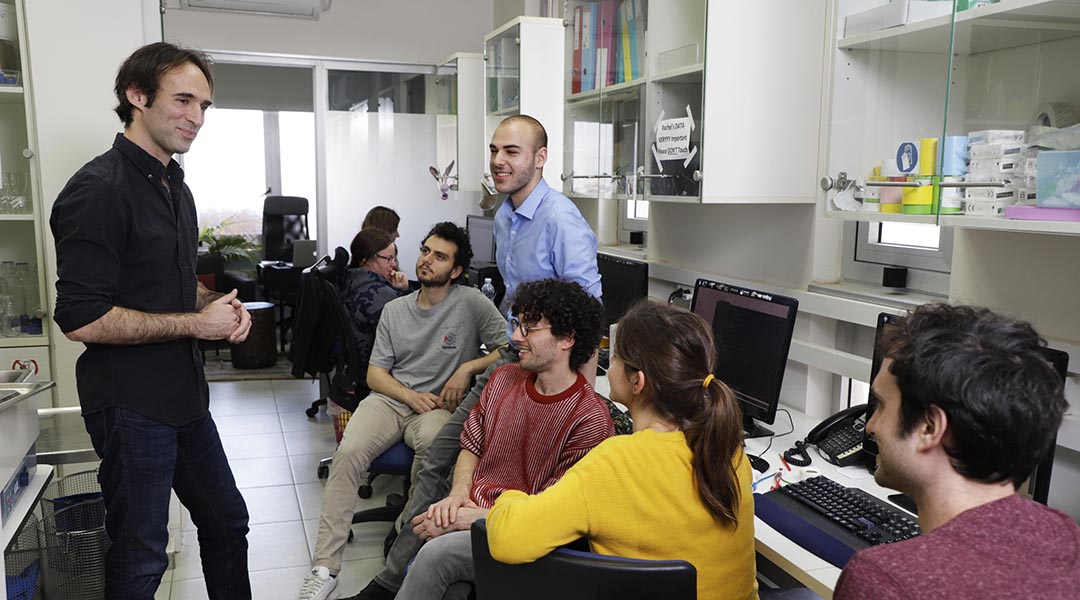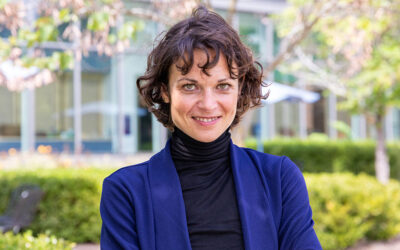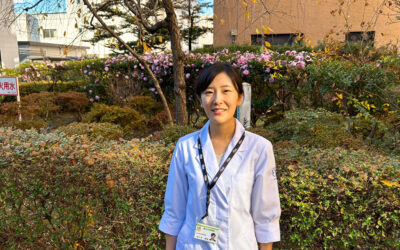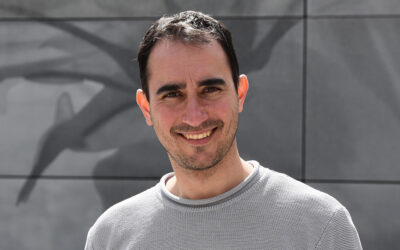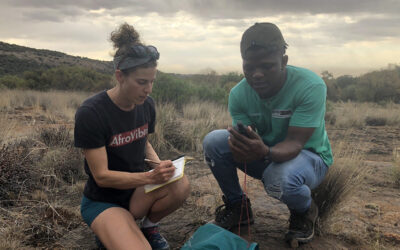Oded Rechavi is a man of many interests. From science, to art, music, language, and sports, his research pursuits mirror his broad interests, where he applies his knowledge to explore beyond the boundaries of neurobiology.
With an open and inquisitive mind, Rechavi has created a unique working environment in which his students and collaborators pursue fascinating projects from different research fields. Outside of his work on inheritance and evolution, his team has been studying how brain parasites can be used to cure diseases by having them deliver proteins to manipulate malfunctioning neurons. And worlds away from his typical area of research, his team also supported biblical scholars in their quest to assemble the 2000-year-old Dead Sea Scrolls from the Qumran Caves.
In addition to his academic accomplishments, Rechavi is also very active on Twitter, using his platform to pull back the curtain on the scientific process and the life of a researcher. His Tweets blossom out of a sincere passion for his work, and readers connect with his honesty and wit, which has led to a growing following over the years.
When did you decide to become a neuroscientist?
I decided to become a neuroscientist kind of by accident. In Israel, we all have to go to the army after high school, so I was there for three years. Then I went to Paris to study to become an artist, taking courses in drawing and painting. At one point, I decided I needed to settle down and do something serious with my life, so I ordered a university book with all the options of degrees to study, and I thought about studying psychology and philosophy. Then I saw there was a program in neuroscience, which included psychology, philosophy, and biology. I though this sounded like the cutting edge of research, so I decided to sign up.
I found that I liked biology part the most, and while I stayed in the neuroscience program, I was always interested in neurobiology and questions about memory and how the brain works. It took me a long time to research what we study now in the lab because there were always twists and turns that led me to other questions in biology. I now finally get to study the questions that interested me in the beginning.
What advice would you give future generations of scientists?
That’s a big question. I would say try to do anything in your own style— the way you want to do it. You will have role models to learn from, but you want to present in your own style. I do not want Bob Dylan to perform like Kanye West and vice versa because each person has his own style. Whenever you are writing up your experiments, identify your style and make that your forte. It is your creation, and it must be fun.
Your lab puzzled together the famous ancient scriptures of the Dead Sea Scrolls from the Qumran Caves. How did you do that?
This was an amazing and fun project we started totally by accident. On a university retreat, I sat on the bus next to Noam Mizrahi, a biblical scholar who studies the Dead Sea Scrolls. For those of you who do not know, the Dead Sea Scrolls are ancient manuscripts, probably the most important archaeological finding in the history of Israel, that were found in the desert in caves in the 1940s and 1950s.
It is so important because these are ancient manuscripts written about 2,000 years ago and they are considered the oldest known Bible. The next one is only around 800 years old. The problem is they found many pieces, approximately 25,000, but they did not how know how to assemble some of them. You can compare it to trying to solve an unknown number of puzzles with an unknown number of pieces, where many of the pieces are missing. People used everything that they could and all the clues that they had to try to assemble them over the years. They looked at the shape of the pieces, their color, and the style of the font. In certain situations, they also examined the content because we know the text of the Bible, so it is like having the picture of the puzzle on the cover of the box. However, in some cases there were texts which were not known before the discovery of the scrolls that are particular to this collection.
We took advantage of the fact that the scrolls were written on parchment that was made from animal skin, and from each piece we extracted ancient DNA (more than 2000 years old) and sequenced it. Then we use the sequences to try to assemble the pieces together.
We said this piece and this piece came from the same animal and this piece came from a different animal. When I say animal, we are talking first about animal type, so sheep versus cow or goat, but we also did assemblies. In these assemblies, when the pieces were made from the same animal type — and in fact most of the pieces we found were from sheep — we could distinguish how close they should be placed together.
We did this while my collaborator Noam gave us the context for the discoveries. The paper was published as a biology paper in Cell, but it is also a history paper, so it is written in a very unusual way, combining the different fields. We learned a lot about other fields and our collaborators are amazing scholars with unbelievable knowledge. Of course, there are many open questions and this is just the beginning, but this is a new tool you can use to assemble the scrolls, which is very interesting.
Can you tell us a little bit about your laboratory’s research into inheritance and evolution?
Although we study many topics in the lab, our main focus is epigenetic inheritance, namely inheritance that occurs via other heritable molecules, aside from changes to the DNA sequence. In my lab, we focus on inheritance of small RNA molecules that are inherited via completely different mechanisms, at least, in the simple nematodes that we study, which are called C. elegans. There are people who address this topic for many different angles. Some people are geneticists, some are biochemists, and others are coming from the evolutionary perspective. We try to combine all of this, but our interests are all a little different.
Inheritance of small RNAs enable things that DNA-based inheritance doesn’t, most notably inheritance of the parent’s responses. In the lab, we study which parental responses transmit across generations, how significant it is, and if it can ultimately affect the process of evolution. We do this mostly using C. elegans [a type of worm], because it is such a powerful genetic organism, where you can easily separate nature from nurture and get at the mechanisms.
There are many advantages in using surrogates for studying epigenetics. For example, the generation time is just three days in C. elegans, so you can easily study many generations. Each worm produces hundreds of babies that are almost genetically identical, so you know whether the effect comes from the environment or because of some genetic change. You also have powerful tools for manipulating them, monitoring the changes, and controlling their environment.
When it comes to epigenetic inheritance, you want to make sure all the conditions are always the same because you never know what might have an adverse effect. Maybe I starved the worms five generations ago, and I am still seeing some traces of that. In the past, C. elegans researchers didn’t care about that because the DNA does not change because of the environment. So, you would, for example, speed up the worms’ development by shifting temperatures or starve them to synchronize their growth, but we have to account for epigenetic inheritance reasons.
Your laboratory engineers brain parasites to deliver therapeutics for disease treatment. Which parasites do you use, and which diseases do you target?
This started as a side project but became very big and we could not do this alone. We have had many collaborators, because we did not start as Toxoplasma experts [parasites related to the malaria parasite].
We took advantage of the fact that Toxoplasma gondii can reach the brain and deliver its own proteins to manipulate neurons. We fused different therapeutic proteins to the proteins that Toxoplasma normally delivers to the brain so they will hitchhike to the brain. Toxoplasma has different secretory systems and we manipulated two of them for the delivery of proteins. This works both in cell cultures and in vivo in mice.
The first disease that we focused on, only as a proof of concept, was Rett syndrome —an incurable neurological disorder. There is only one gene and protein that you need to fix to restore function, which is called MECP2, or methyl CpG binding protein 2. There are also attempts to do gene therapy by restoring the right amounts of this protein, but this is not easy because, among other things, that the protein is big. With Toxoplasma, we can deliver proteins that are much bigger compared to other techniques.
Toxoplasma forms cysts in the brain. How do you get rid of the parasites once they have done their duty?
Toxoplasma can sit in your brain dormant and not do too much damage if you’re immune-competent, but nevertheless, ideally you would get rid of it. We are not there yet, but in theory in the future maybe you could engineer toxoplasma auxotrophs — organisms that are unable to synthesize molecules necessary for growth and development — to a certain substance so it will only survive a while and then die, or we could perhaps have a sort of death cassette in the parasites’ genome that will allow us to then kill it with a specific compound.
Other people actually designed auxotrophic Toxoplasma, but our lab has not tamed the parasite yet, and this would be something that will need to be done to make it safer in the future.
When you work with the parasites, how do you engineer them to do what you want them to do?
Genetic engineering on Toxoplasma is relatively simple, and it is used as a model organism for many other organisms, like malaria. We can use genetic engineering to fuse therapeutic proteins to proteins that are naturally secreted from the parasite’s different secretory organelles.
One organelle is the rhoptries, which is like a harpoon the parasite shoots into the designated host cell to infiltrate it. The protein it uses to do this is called toxofilin, so we make fusions of the therapeutic protein MECP2, and the parasite’s toxofilin protein. The idea is that the parasite will carry the curative protein (MECP2) into the cell to help treat the disease.
While looking for the right parasite protein to use for the delivery of MECP2, we studied different candidate proteins that are efficiently secreted by Toxoplasma. There is another parasitic protein called GRA16, which is secreted from another secretory organelle the parasite uses once it is already inside the host cell.
From this work, we’ve got some interesting results that also tell us a little bit more about the biology of the parasite in addition to our attempts at making it do something useful.
You have a very impressive Twitter following. How did you get started on social media?
I never used Facebook or social media a lot, and I only I joined Twitter in 2016 to Tweet a paper we had published. I got maybe 20 likes or something, so not so much, although it was a very cool paper.
I started making funny Tweets about academia in parallel to discussing and highlighting the science, and then it just became more and more of a thing, and it became a bigger part of my life. Now the account and the jokes are really well known, but I am not doing it as a sort of strategy or think of it as work. I just do it for the fun and to laugh and to find out about science. In fact, I have really reduced the time I spend on the app. I erased it from my phone 90 days ago, and since then, I use it probably 10 minutes a day. I still do quite a lot in those 10 minutes, but I do not use it much beyond that.
Can you tell us how you use social media as a scientist and what role it plays, good or bad?
I think the time you might waste on social media, and specifically Twitter, you can control. I managed to reduce my time on the app significantly. A bad side is you can sometimes get yourself into trouble. For example, some people might think I am not serious enough, but I do not care about that too much.
The good side compensates for that because you get to know a lot of people and your science becomes more well known. At the moment, the last preprint I shared got more than one million impressions, which is probably a lot more than any scientific journal in the world. The exposure is huge.
Another very important thing is that you really learn a lot about science. You hear about everything that is new, every preprint, every talk in a conference, every topic that is being discussed in the scientific community. You just cannot compare it to periodically searching PubMed. The good of social media (for science) outweighs the bad significantly, in my opinion.
How do you come up with your tweets?
There is really no method. About 90% of the time, I start with a visual, like a funny video or picture I stumbled upon, and then it is just free association I write an idea for a Tweet very quickly, and if I think it is not funny or could be offensive in some way, then I erase it. That is my method.
Do you think social media platforms like Twitter make scientists more accessible?
In my case, most of the people who follow me are scientists because I communicate with scientists and most of my jokes are about science. Nevertheless, there are also other circles of people on the platform that aside from learning about science, which is important, they learn that scientists are human beings, and they learn more about the scientific method.
Most people do not know how peer review works, or how we fund our work, or the process of how we get promoted. I think when they learn about it, there is more transparency, particularly with all the conspiracies now about science and “big pharma” during COVID-19. People need to see the behind the scenes to understand what we are trying to do and why it is important.
I also think scientists learn a lot about the scientific life from Twitter. Otherwise, you are within your lab or your institute and you do not know what actually goes on in the world, what is a good code of behavior, how to plan your career, etc. Scientists gain from Twitter not just by learning about a new paper, but also learning about the full spectrum of scientific careers.
What is…
The origin of your nickname “Pretzel”?
That is easy. Almost every day, I just eat a pretzel for lunch because I do not have much time. I normally talk to someone and just take a pretzel and eat it while we discuss.
A hobby you pursue in your free time?
I am trying to learn the guitar and French now, but my favorite hobby is basketball, although I do not get to play much these days. I am a New York Knicks fan.
A song you could constantly listen to?
DNA by Kendrick Lamar
Who would play you in a biopic?
People say I look a little bit like Nicolas Cage.
A discovery, any research, any time in history, you wish you would have made?
Mendel’s Laws.
A person, famous or not, you would like to meet?
Michael Jordan.
Follow Oded on Twitter @OdedRechavi

